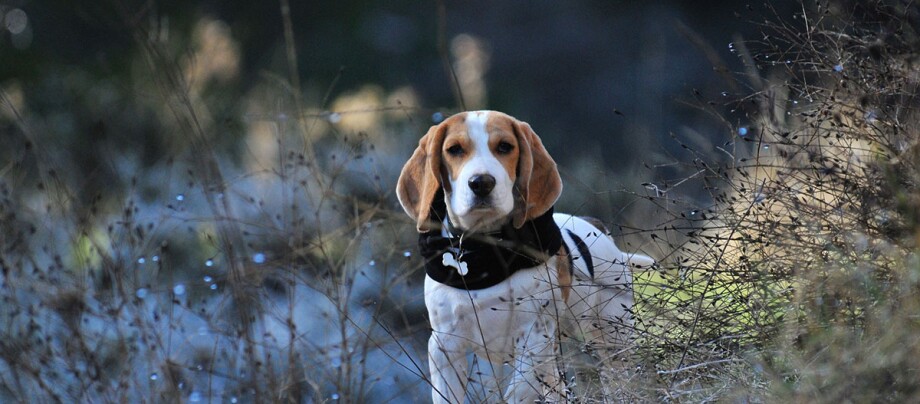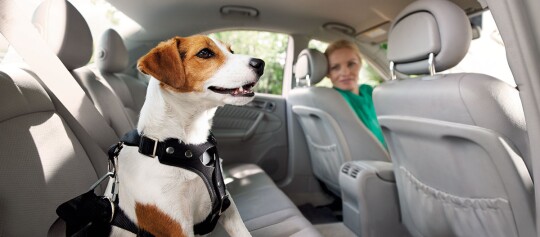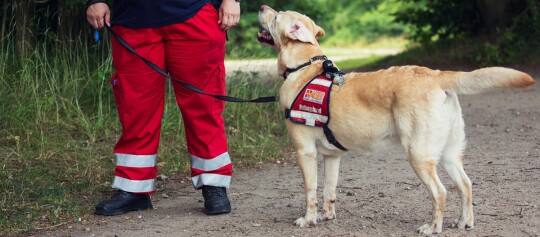Beagle – a good nose with a big heart
18.11.2024 - Reading time: 9 minutes

Of course you will be familiar with the most famous beagle in the world – Snoopy – the aviator ace on top of his dog house. His real breed representatives are considered paragons of good nature and philanthropy, but also stubbornness. Their character makes the spotted hounds ideal family dogs, especially if you have small children or babies in the house.
- Blossoming at the Tudor court
- The Beagle’s character
- Beagle profile
- Is a Beagle ideal for first-time owners?
- Are Beagles easy to train?
- Is a Beagle dangerous?
- Does a Beagle make a good family dog?
- How much does a Beagle puppy cost?
- Buying a Beagle: What to consider
- What are a Beagle’s needs?
- Taking care of a Beagle
Blossoming at the Tudor court
The origins of the breed can be traced back to ancient times. The first written account of the Beagle dates back to Tudor England. Large packs of the animals, originally bred as cattle and dragging dogs, were kept at the royal court. They were a favourite choice for hunting rabbits. The Beagle has been an officially recognised breed since 1890. According to the current breed standard, the Beagle stands at around 33 to 40 centimetres at shoulder height. Earlier examples of the breed were significantly smaller: The dogs were bred to be able to fit in a saddlebag.
The Beagle’s character
The Beagle is an extremely sociable, lovable and placid dog that almost never shows aggressive behaviour towards people and is even friendly towards strangers. This means that it does not make a very good watchdog: A Beagle is simply too nice to be disrespectful. However, it can sometimes be vocal and watchful. However, it is unlikely that it would defend itself against a burglar – especially as its greediness means that is susceptible to bribery.
In addition to this lovable and obliging side, Beagles possess unshakeable self-confidence and a certain degree of stubbornness. This is what enables them to solve problems by themselves. What used to be a desirable trait when used for its original purpose can also present a challenge for some Beagle owners when trying to train their dog.
The Beagle forms a close bond with its people and enjoys being part of the family. One small character flaw is its greediness: A Beagle will not pass up any opportunity to nab a tasty morsel.
NewsletterBeagle
Breed | Beagle |
Origin | Great Britain |
Classification | Bloodhounds and related breeds |
Size | 33 to 40 centimetres at shoulder height |
Weight | 9 to 18 kilograms (average 10 kilograms)
|
Physique | Compact, muscular, high set, thick tail |
Eyes | Dark brown or hazel with a soft expression |
Ears | Low-set, floppy ears |
Coat and colour | Dense in structure and water-repellent; black, white and brown in colour or two-tone with white paired with brown, red or lemon |
Special features | Extremely friendly character, food-obsessed |
Nature | Good-natured and friendly, enjoys being active |
Care | Easy to care for; brush, wash briefly and towel-dry every now and again |
Health | Predisposition to spinal disc degeneration, joint and eye diseases |
Is a Beagle ideal for first-time owners?
The Beagle is gentle, friendly and well-rounded in nature, which can make it an appealing choice for first-time owners. However, due to its prey drive and certain degree of stubbornness, whether or not a Beagle is in fact well suited to first-time owners is a hotly contested issue. As long as you adopt a loving, consistent approach to training and ensure that a Beagle’s needs are being met, even as a first-time owner, you are sure to do well with a Beagle. Before buying a Beagle puppy, you must therefore check that you meet the requirements for this breed. It is generally advisable to enlist the help of a dog trainer or dog training school when training your dog: This will help you get off to the right start and avoid training mistakes.
To ensure that you end up with an obedient Beagle – insofar as this is possible for a Beagle – you should be patient and persistent with its training. As a tracking dog, the Beagle might ignore your commands as soon as it has picked up an exciting scent. If you do not want to find yourself calling after your Beagle to no avail and spending long periods of time alone in the woods, persistent and consistent training is key. Ideally, you will work on your dog’s obedience using tracking and searching games – using appropriate rewards to reinforce the desired behaviour. But be careful: The treats should be as low-calorie as possible. It is also important that you use them in a targeted way, so that your Beagle still feels it is worth the effort of having to work for them. It should also learn to be happy with words of praise instead of snacks. Otherwise you run the risk of having a well-behaved, but overweight dog. You can also help to maintain and strengthen your bond by playing scent games etc.
Experienced dog owners may find that they have an easier time of it with a Beagle. However, this is only true if, in addition to your experience, you are assertive and have plenty of patience and persistence when it comes to training, as you will always find traces of the Beagle’s origins as a working and hunting dog in its character. The most important lesson for first-time owners and experienced owners alike is therefore ensuring that you can recall your dog, that it listens to its name right away and comes back to you when you want it to – no matter how enticing the scent is, because you are ultimately responsible for your dog and its safety.
Are Beagles easy to train?
Even though the Beagle has a gentle, distinctly friendly nature, it is not necessarily easy to train. Its character traits, such as a strong prey drive and wilfulness, mean that a consistent and safe training style is essential. Obedience is probably the biggest challenge that Beagle owners face. However, if you are looking to get a dog that happily hangs on your every word, a Beagle is not the best choice.
Is a Beagle dangerous?
The Beagle is known for being a friendly and gentle dog. Aggressive tendencies are extremely rare and are not in its nature. Nevertheless, it all depends on who its people are and the experiences it has had. Unsuccessful or traumatic training can cause any dog to become dangerous or liable to bite. However, a Beagle is not a dangerous breed by nature and does not tend to behave aggressively even in adverse circumstances.
Does a Beagle make a good family dog?
Due to its good-natured character, manageable size and controllable strength, the Beagle is often thought of as a good family dog. The fact that it loves spending time with its people and is very patient when dealing with children works in its favour. Doing activities at the park or in the forest together with the whole family makes the Beagle happy. But even though beagles are seen as dogs that will let children away with almost anything, it is still advisable to always keep a watchful eye on the little ones and the dog. Even more so, the younger the children are. Another question is how well a consistent training style can be implemented when there are children living in the household. Older children and teenagers are generally more likely to get involved and can work together with you when it comes to training. However, you should never give them sole responsibility for your dog. The younger the children are, the less well you can expect them to understand and observe the training rules.
How much does a Beagle puppy cost?
It is not easy to give an average price for a Beagle. The price can range from 800 euros to well over 1000 euros, depending on which breeder you buy from. If you are looking to buy a Beagle puppy, the price should not be the most important consideration, but rather choosing a reputable breeder.
In addition to the pedigree Beagle there are also Beagle mixes that are considered a breed in their own right. These include the Puggle, which is a cross between a Pug and a Beagle, and the Beagle-Harrier, which is a cross between a Harrier and a Beagle.
Of course, a Beagle mix with another breed could be another option. If you are not necessarily wanting a Beagle puppy, it is also worth enquiring at your local animal shelter.
Buying a Beagle: What to consider
If you are looking to buy a Beagle, make sure that the seller is reputable! Scepticism is advisable, for example, if dealers are reluctant to answer your questions and are unwilling to show you the dogs’ home environment. A trustworthy beagle breeder will be only too happy to show you their animals, including the puppies’ mother, and their environment. A serious breeder will also never give the Beagle puppies away too soon: the pups and their mother should remain together for a sufficient period of time. If a puppy’s bond with its mother and siblings is broken too soon, they may develop behavioural issues. A responsible breeder will therefore never give you a Beagle puppy under 12 weeks old. They may also ask you questions – do not take offence, but rather see this as a good sign: A good Beagle breeder wants to know that their dogs will be in good hands.
What are a Beagle’s needs?
Company and exercise are the most important considerations when caring for a Beagle. Beagles need a lot of stimulation and exercise to tire them out. Long walks in areas with exciting scent trails are perfect. Once a Beagle has picked up a scent, it is not easy to stop and will lead the way, because sniffing is in its blood. This is why the Beagle is also used today as a professional sniffer dog. Examples of some appropriate activities that will keep your Beagle entertained are search games involving scent work and tracking.
Thanks to its small size it can also live in an apartment, however, a house with garden is much more suitable, but the garden should be fully secure. Low fences are no obstacle for a Beagle on the trail of the neighbour’s cat – it will dig its way to freedom if it has to. Make sure that your four-legged friend does not become bored to stop them from getting any silly ideas.
Taking care of a Beagle
Although the Beagle’s short coat is low-maintenance and needs no more than the occasional brush and possibly a shower using dog shampoo, you should pay particular attention to ear care. Their floppy ears are prone to inflammation. If you are not sure how best to keep their ears clean, speak to your vet.
To keep your Beagle healthy and give it as long a life as possible, make sure it stays slim: This ever-hungry four-legged companion has a tendency to be overweight, which needs to be balanced out with sufficient exercise. An adult Beagle weighs between 10 and 18 kilos, depending on the size of the dog. Also check your dog’s claws regularly and trim them if necessary. If well looked after and provided with an optimal diet and veterinary care, Beagles can live to around 15 years of age.

